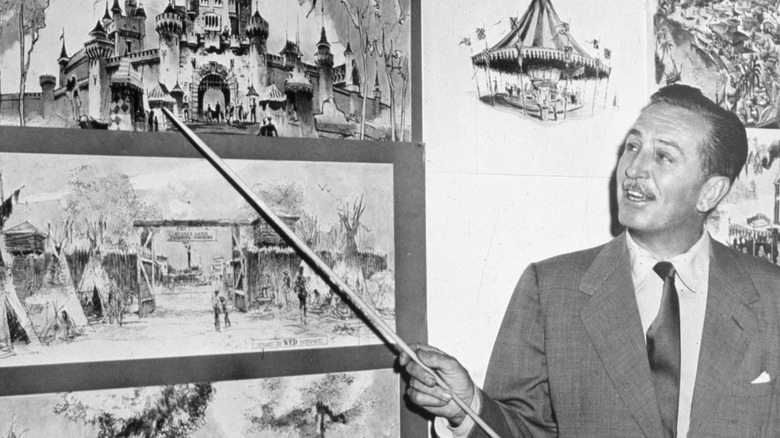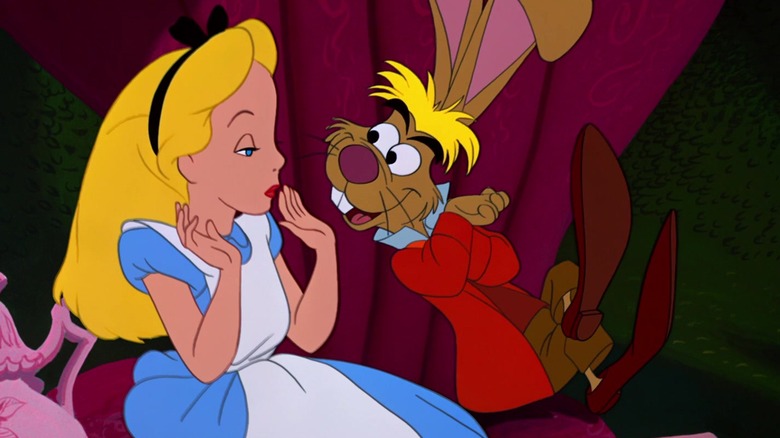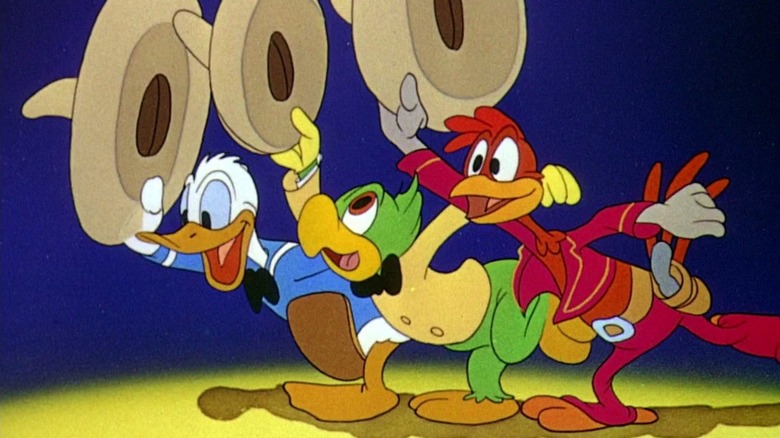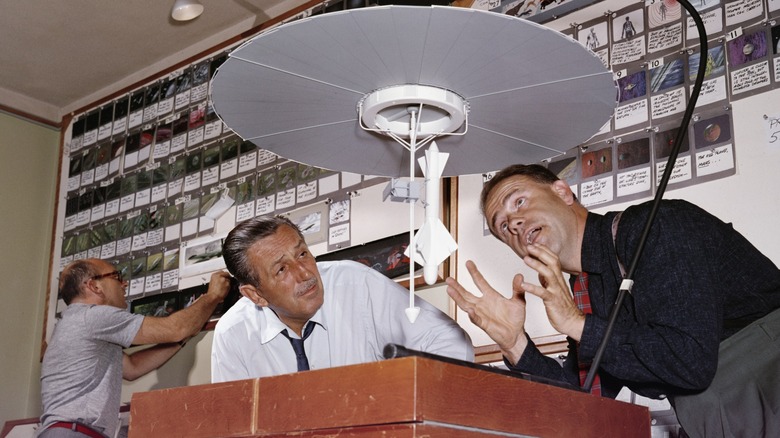Disney's First Big TV Show Had A Sneaky Ulterior Motive
The Walt Disney Company loves few things more than its own lore, and its ability to promote that internal mythology is second to none. 2025 marks the 70th anniversary of Disneyland Park, the original theme park that helped Disney expand beyond its collection of animated feature films and shorts. Disneyland allowed guests to interact with beloved and iconic characters like Mickey Mouse and Donald Duck, as well as princesses like Snow White and Cinderella. The characters had essentially leapt off the screen, as had some of the most exciting and adventurous scenes in other well-known Disney titles. 70 years later, it seems like a fait accompli that Disneyland would be a rousing success; how could it not be? But Disneyland was far from a guarantee when it was under construction and when the studio had to market the theme park to a country full of people who didn't quite know what such a theme park even was. Amusement parks had existed for decades prior, but a theme park centered around specific lands, themed characters, and stories was entirely new.
Something else that was relatively new in the mid-1950s: television. The small-screen medium wasn't entirely unfamiliar to audiences in the middle of the decade, but it was still in its infancy. While this had its drawbacks, just as some audiences simply hadn't adopted the technology yet, it also could be used to the advantage of Walt Disney and his staff. Considering how adept Disney is at cross-promotional purposes now, it should come as no surprise that such marketing prowess really started with the Disney anthology TV series. Nowadays, we know it best as "The Wonderful World of Disney," but it's had many names, such as "The Disney Sunday Movie" and "Walt Disney's Wonderful World of Color." When it premiered in 1954, the show was simply called "Walt Disney's Disneyland," and it existed primarily to make sure people knew what Disneyland was going to be, when it would open, and what it would offer to guests.
Walt Disney's Disneyland was a glorified promotional tool for Disney
As much as the existence of "Walt Disney's Disneyland" had an ulterior motive in selling the eventual theme park to audiences during its first nine months of existence (the first episode aired on October 27, 1954; Disneyland opened its doors on July 17, 1955), the show had a different ulterior motive in being pitched: Disney needed additional funding to complete the park and was essentially hoping that whichever network aired his show would help bring the park to the finish line. The eventual victor was ABC, though it should be noted that this was four decades before a much different and bigger version of the Walt Disney Company bought ABC. At the time, Disney signed an agreement to make 21 hourlong episodes of an anthology series per season for three seasons, though the terms of the deal would eventually change. (Only the first season, all of which aired before Disneyland opened, produced 21 episodes. Future seasons aired between 26 and 30 episodes, and the TV series ended up airing, initially, for seven seasons on ABC.)
From the outside in, the idea of "Walt Disney's Disneyland" was quickly established in its introductory montage, making clear that episodes were divided into one of four groups: Adventure Land, Fantasy Land, Frontier Land, and Tomorrow Land. Eventually, those two-word groups would turn into one word each, in alignment with the corresponding land at Disneyland Park. Both because television was still so new and so easy to experiment with, and because Disney only had so much money, the first season managed to set the tone for the future 10 or so seasons hosted by Walt Disney (before his passing in 1966) while also leveraging the studio's past work. While the series premiere is fittingly titled "The Disneyland Story," meant to tee up what the park would encompass while also reminding audiences of the many beloved characters populating Disney's stories, future episodes presented condensed versions of Disney films. (Literally, the second episode, airing on November 3, 1954, is a trimmed-down version of the 1951 animated film "Alice in Wonderland.") "The Disneyland Story" is, as a premiere, aware that what it's describing is entirely new, and that giving audiences a peek behind the curtain of how both the park was being built and how movies are made at all was a little bit of a bonus. Even before Disney is introduced and unveils a massive map of what Disneyland would look like when it opened, we see glimpses of the behind-the-scenes production of the first Disney blockbuster, "20,000 Leagues Under the Sea," and early live-action reference work for the studio's 1959 classic "Sleeping Beauty."
But the meat of the episode is about Disneyland itself. As Disney himself states, "Disneyland the TV show and Disneyland the place are all part of the same [thing]." In truth, when you watch "The Disneyland Story," it becomes clear that the pilot is doing two things: one, making clear what the audience can expect from future episodes; and two, subtly seeding in the idea that the Disneyland theme park itself would offer a similar array of experiences. The episode offers glimpses into what each of the four "realms" of Disneyland would offer. In Frontier Land, we get an early preview of the Davy Crockett miniseries starring Fess Parker, as well as the character's song. In Adventure Land, you get a glimpse of what would amount to nature documentaries about different parts of the world. In Tomorrow Land, you get a brief lecture and corresponding visuals about how man is attempting to conquer outer space in the near future. Before Disney himself trotted out a line any passing fan knows all too well — "It all started with a mouse" — and showed clips of Mickey throughout the 25 years in which the character had appeared in shorts, Fantasy Land featured an extended section of the highly controversial 1946 film "Song of the South."
Disney helped to revolutionize television with Walt Disney's Disneyland
In essence, "The Disneyland Story" does a very good job of something TV critic Alan Sepinwall has sometime noted: teaching you how to watch it again and again. Over time, though, the Disney anthology TV series would undergo a vast series of changes. When Walt Disney died in the mid-1960s, the original foundation of the show began to crumble. It's not as if his being the ringleader of the series was crucial to the concept of each episode falling under one of four creative buckets, but without Disney to steer the show from the outside or inside, the determination and drive to do so wasn't as present. In fact, even before Disney died, the four groups had begun to dissipate (partially because the overarching work on Disneyland, as well as Disney's eye towards future projects like what would become Walt Disney World, took up so much of his time). Weekly episodes were now more likely to showcase recent live-action fare, and since the show was aired in hourlong installments, these movies would be split into two parts.
Of course, part of why the show's focus seemed to shift gradually was because its initial thrust no longer was necessary. The park was open (and thriving), so the show could take on whatever form it wanted. But the first season particularly allowed audiences to get a glimpse into what Disneyland would be like from the comfort of their own home. "Walt Disney's Disneyland" was successful for a number of reasons; the fact that there were only so many networks and thus so many programs was one key aspect, but what the show offered was also both distinctive and different from other series. In some ways, Disney was revolutionizing a number of now-familiar facets of the televisual landscape. Even in the first season, he was comfortable turning his films into small-screen marvels, with the aforementioned "Alice in Wonderland" joined by a condensed version of "The Three Caballeros" and a two-part presentation of the 1950 adaptation of "Treasure Island." But he also used his platform to argue in favor of space travel with the eventual Oscar-nominated short film "Man in Space," which blended Disney's penchant for gag-driven animation with wonky science to explain how man could survive in the deep reaches of outer space.
Walt Disney's Disneyland is a vital piece of TV history that Disney doesn't care about
More than 70 years later, it's hard to imagine a world of entertainment that does not also feature Disneyland. For just about anyone reading this article, Disneyland has just been a part of the fabric of American popular culture for our entire lives. Thus, to watch "Walt Disney's Disneyland" is something of a fascinating historical curio, in no small part because Disney as a whole doesn't have much interest in letting audiences look back officially at many of the show's episodes. While it's true that some of the episodes of the Disney anthology TV series amounted to re-running films (many of which you can already stream on Disney+), there are plenty of episodes or made-for-TV movies airing as part of the show that you can't find or that you could accidentally stumble upon while on the streaming service. If you know which titles to look for, such as the previously mentioned "Man in Space" or "The Plausible Impossible," an episode about the art of animation, you can find them on Disney+. (For now. Who knows at what whim a bean counter will argue that such old episodes no longer make money for the House of Mouse?)
But there's no good reasoning for why many of these episodes are unavailable, including perhaps the most notable of all. The first season of "Walt Disney's Disneyland" climaxed on July 13, 1955 with "The Pre-Opening Report from Disneyland," which gives the worldwide audience a glimpse into what Disneyland was shaping up to be in the literal hours before its first day of operation. While that hour of TV is available on Disney+, the corresponding live event "Dateline: Disneyland" from July 17, 1955 itself is not. That summertime special was technically outside of the "Walt Disney's Disneyland" show, but was a vital conclusion to the year of episodes preceding it. With hosts like Art Linkletter, Disney, and a pre-presidential Ronald Reagan, "Dateline: Disneyland," which is absolutely available on YouTube, and has been made available on Disney home media in the past, is as critical to the park's success as the first season of this anthology show. (And as you might imagine, since it aired in the mid-1950s, and was focused on a never-before-done theme park, it's got a number of slip-ups that are charming to watch in context.)
The concept of the Disney theme parks is so heavily ingrained in our minds now that it may be difficult to wrap your head around the fact that the original theme park was never a guarantee, and "Walt Disney's Disneyland" was a huge part of helping audiences around the world accept and buy into it as a proof of concept. (That is one of many reasons why it might be nice if Disney+ streamed a lot more episodes from the original show.) Walt Disney was effective at many things, but he was a master showman above all else, and so the televisual medium was a perfect fit for his needs. It's not that the Disney anthology TV series in its current wisp of a form (usually trotted out for live holiday parades or anniversary specials) can't sell audiences on the Disney theme parks. It's that "Walt Disney's Disneyland" had to sell audiences on something they had never experienced before, instead of reminding us about what the parks are capable of creating. The magic of the Disney theme parks is almost old hat to the audiences of 2025, but in 1955, Disney had to use this show to create that magic from the ground up.



